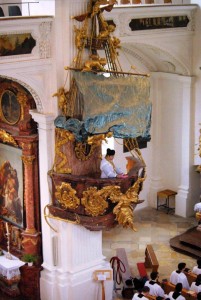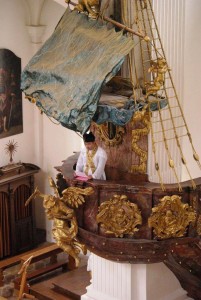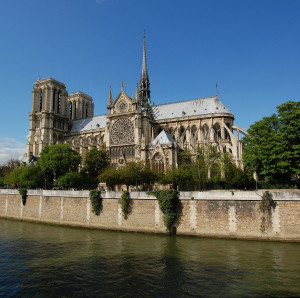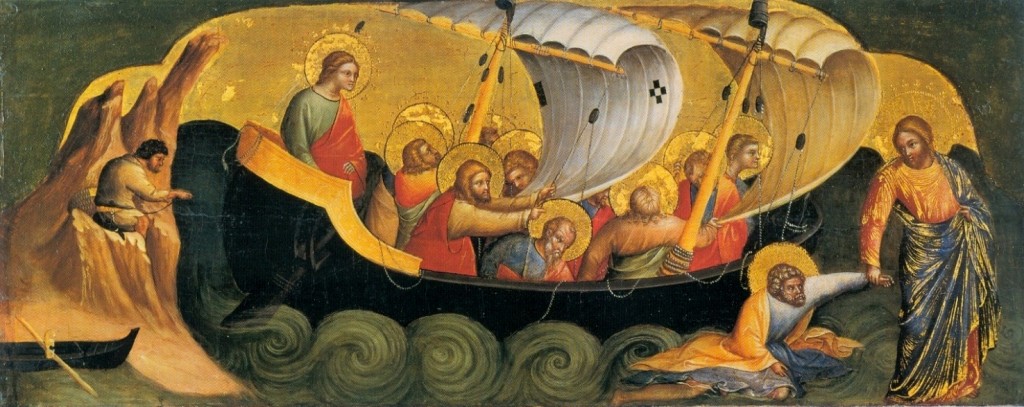Continuing this series on the GUIDEBOOK FOR THE PILGRIM SOUL, let us examine more closely the analogy of the Christian soul on a ship set forth to reach the shores of Heaven.
[featured-image single_newwindow=”false”]
First off, one of the primary sources of this analogy comes from the symbolism of water. In fact, water has always been associated with death and new life. In particular, Baptism makes visible this invisible reality. On the Sacrament of Baptism the Catechism of the Catholic Church states:
“This sacrament is called Baptism, after the central rite by which it is carried out: to baptize (Greek baptizein) means to ‘plunge’ or ‘immerse’; the ‘plunge’ into the water symbolizes the catechumen’s burial into Christ’s death, from which he rises up by resurrection with him, as ‘a new creature.'” (CCC 1214)
Additionally, water reflects this theme of death and life in Sacred Scripture:
“Since the beginning of the world, water, so humble and wonderful a creature, has been the source of life and fruitfulness. Sacred Scripture sees it as ‘overshadowed’ by the Spirit of God:
-
At the very dawn of creation your Spirit breathed on the waters, making them the wellspring of all holiness.” (CCC 1218)
Connecting both the Sacrament of Baptism and Scripture, the Church “has seen in Noah’s ark a prefiguring of salvation by Baptism, for by it ‘a few, that is, eight persons, were saved through water’:
-
The waters of the great flood you made a sign of the waters of Baptism, that make an end of sin and a new beginning of goodness. (CCC 1219)
Furthermore, “If water springing up from the earth symbolizes life, the water of the sea is a symbol of death and so can represent the mystery of the cross. By this symbolism Baptism signifies communion with Christ’s death.” (CCC 1220) [Emphasis added]
And lastly, “Baptism is prefigured in the crossing of the Jordan River by which the People of God received the gift of the land promised to Abraham’s descendants, an image of eternal life. The promise of this blessed inheritance is fulfilled in the New Covenant.” (CCC 1222) [Emphasis added]
Many Saints have seen the beauty of this analogy and have applied it to Christian life. Often they will use the Blessed Virgin Mary’s title,“Star of the Sea,” as a springboard into this analogy. For example, Saint Bonaventure wrote from Mary’s point of view these words:
“O poor lost sinners, despair not; raise up your eyes and cast them on this beautiful star; breathe again with confidence, for it will save you from this tempest and will guide you into the port of salvation.”[i]
There are many more Saints who have wrote about Our Lady, Star of the Sea, and I will devote a few articles on this subject at a later point.

This beautiful imagery did not take long to find physical form in the art and architecture of churches. For example, the area between the narthex and the sanctuary was called the “nave.” This word comes from the Latin navis, or ship and was meant to portray the reality that the Church is a ship, protecting those inside it from the waves and buffets of the world.[ii]

Architecturally, many artists would make this analogy even more visible by constructing the ceiling over the nave in a vaulted fashion, exposing the wooden beams, which resembled the reversed look of a ship’s keel. Furthermore, inside the nave can sometimes be found a pulpit that is made to look like a ship. This accents the symbolism and visibly puts the priest as the pilot of the congregation, leading them to distant shores. Furthermore, it has been said that the exterior flying buttresses of Notre Dame Cathedral in Paris represent oars and further realize this image of the Church as a ship who brings her people to safe harbors.
As it can it be seen, the Church has kept within her treasury this analogy of the sea being a “symbol of death” along with the crossing of water (specifically the Jordan River) as “an image of eternal life.” Consequently, a PILGRIM SOUL out at sea is one who is united to Christ’s death in search of eternal life.
Throughout the next few articles I will return to this analogy and many more examples of how the Church has used this image especially in the writings of the Saints. Next week, we are ready to open the first pages of the GUIDEBOOK and take the initial preparations for embarking on the great journey of life.


[ii] Denis McNamara, How to Read Churches: A Crash Course in Ecclesiastical Architecture, (New York: Rizzoli, 2011), 90.

